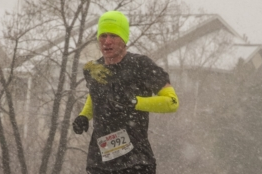The wind howled and blew the wet snow in every direction imaginable. It had been this way all night and the 5K I was warming up for was set to start momentarily. Part of the course was on dirt paths, including the beginning. When the race started, several people wiped out in the opening 200 meters as the trail had been reduced to mud soup. I had a certain time goal in mind, but that went completely out the window in the first mile and I focused on running hard, staying upright, and hoping for a solid place…
What is the ideal training weather? All of it, barring hurting yourself. If you don’t believe me, then ask yourself this question. What will the weather be for the race you signed up for three months from now? Yep, you have no idea. Sure, if it’s between June and August and you’re in the continental U.S. it will likely be warm. But you could still have a hard rain and/or wind.
Short of putting myself in a dangerous or health/injury compromising situation, I get out and run, no matter the conditions. For the snow, a good pair of Yak Trax or similar anti-slipping gear doesn’t cost too much. A warm running jacket and warm running pants, while potentially inducing sticker shock, will last for years if you take care of them properly. For those sub-zero days, I wear running tights under my running pants and slip on a pair of mittens over the gloves. I’ll cover my face with a neck gaiter and one other item, like a bandana. (My lowest temperature so far is either 8 or 9 below 0. I’m not sure where I would draw the line and hope it doesn’t get that cold where I have to make that decision.)
If it gets into the hot end of the thermometer, drink plenty of fluids ahead of time and carry some with you, even on a short run. (I prefer a sports drink, as it helps replace more than just liquid.) Put on sunscreen and a hat, wear sunglasses. I wear Tifosi right now and have been pleased. Another popular brand right now is “goodr” and part of their appeal is they’re inexpensive. Running hats aren’t too expensive and can survive modern washing machines–I do air-dry mine.
Besides the race above, I’ve run others in rotten conditions, like thirty-four degrees and heavy rain. These races were awful, but I’d trained in conditions much worse and while I wasn’t prepared to set a personal best, I also wasn’t daunted by it.
Above all of this, know your body. I know one runner who won’t go out in anything under 70 degrees and another runner who cringes at anything over 70 degrees. Their bodies react differently and when it gets to temperatures where they struggle, they may hit the treadmill instead. If you’re not sure how you’ll feel in unusually warm or cold weather, take a short run on a familiar path and pay attention to how your body reacts.
Miserable weather can show up for races so I prepare myself accordingly, run outside as much as is practical, and show up to the starting line with confidence.
When I finished the 5K at the beginning of this post, I was in a solid second place and happy to keep trucking from the finish line to the car, where I had packed extra dry clothes.
Running food/drink review of the week (note–gels, bars, chews, sports drinks and other items affect everyone differently. Try them on a short run before using them for a key training run or race): Salted Caramel Gu. Nice flavor, tastes like salted caramel. Good energy boost and with a little caffeine, you supplement any rush you might have missed if you cut back on your coffee on race/long training run morning.
Shoes next time, including free advice (based on three vain decisions I’ve made) on why you shouldn’t go just for looks…

